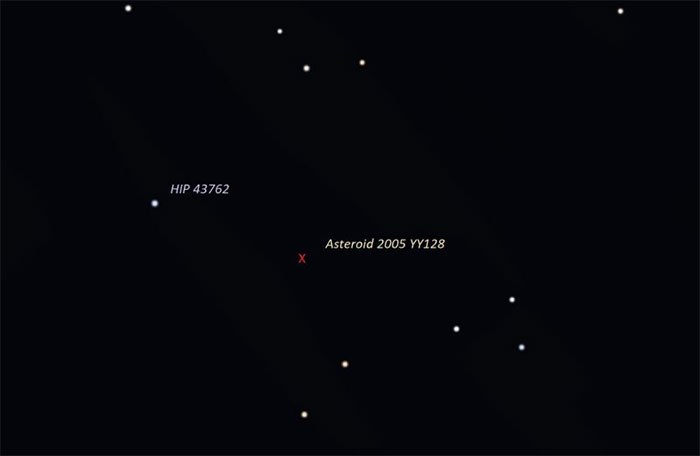The asteroid with a diameter of at least 580 meters passed closest to Earth in the last 400 years on February 16, but posed no danger to the planet.

Location of asteroid 2005 YY128.
Asteroid 2005 YY128 will pass within 4.5 million kilometers of Earth at 7:46 AM on February 16, marking its closest approach in over 400 years, according to EarthSky.org. However, this distance is still 12 times greater than the distance between Earth and the Moon, meaning that this asteroid is not capable of colliding with Earth.
As its name suggests, 2005 YY128 was discovered in 2005 by astronomers at the Kitt Peak Observatory in southern Arizona. Over the past 17 years, the research team has mapped its orbit with high precision. However, their observations have not yet been able to accurately determine the size of 2005 YY128. Instead, they can only estimate its diameter to be between 580 and 1,300 meters.
Consequently, 2005 YY128 is classified as a potentially hazardous asteroid (PHA), which includes asteroids that are at least 140 meters wide and have orbits that come within 0.05 astronomical units of Earth (one astronomical unit, or AU, is the average distance between Earth and the Sun, approximately 150 million kilometers, so 0.05 AU is about 7.4 million kilometers). If it were to collide with Earth, 2005 YY128 could cause significant damage.
According to the non-profit organization Global Challenges Foundation, the largest near-Earth asteroids (NEOs) have the potential to cause geological and climatic impacts on a global scale, disrupting human civilization and potentially leading to the extinction of many species. Smaller NEOs ranging from 140 to 1,000 meters can cause regional or continental damage, resulting in hundreds of millions of fatalities.
Ten years ago, on February 15, 2013, a 20-meter wide meteor exploded over the city of Chelyabinsk in Russia, shattering thousands of windows and injuring some people on the ground. NASA established the Planetary Defense Coordination Office a few years after the Chelyabinsk event. Astronomers and researchers worldwide are engaged in the fight to protect Earth. NASA and its partners have discovered over 95% of asteroids at least one kilometer wide that could pass within 50 million kilometers of Earth, but no hazardous celestial bodies are expected in the near future.


















































